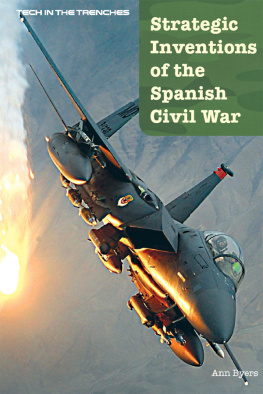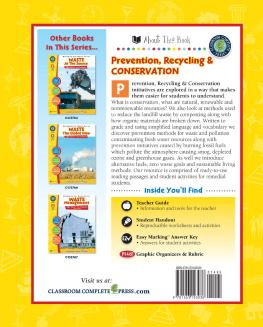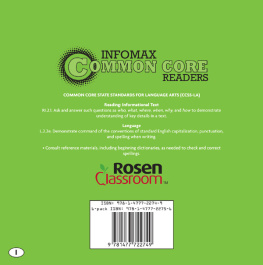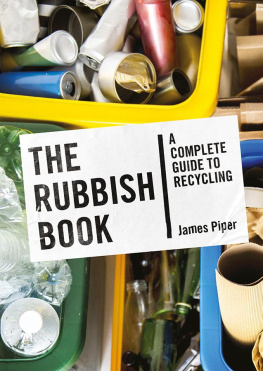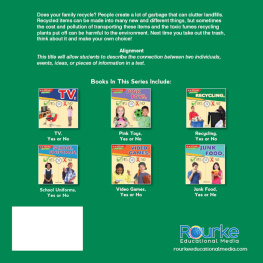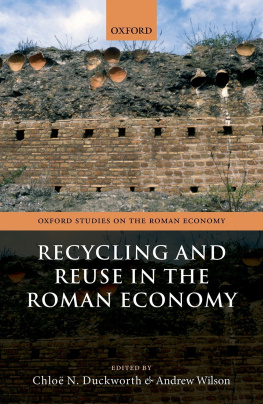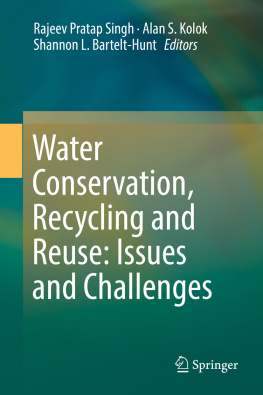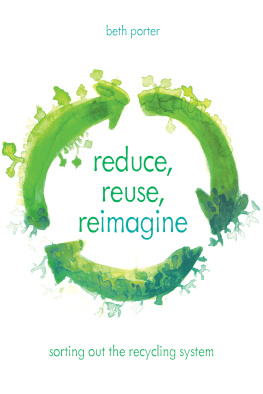- Chapter 1
The World Wakes Up - Chapter 2
Nations Take Action - Chapter 3
Beyond Everybodys Doing It Or Are They? - Chapter 4
Balancing Acts - Chapter 5
The Three Rs Today
Published in 2018 by Cavendish Square Publishing, LLC
243 5th Avenue, Suite 136, New York, NY 10016
Copyright 2018 by Cavendish Square Publishing, LLC First Edition
No part of this publication may be reproduced, stored in a retrieval system, or transmitted in any form or by any meanselectronic, mechanical, photocopying, recording, or otherwisewithout the prior permission of the copyright owner. Request for permission should be addressed to Permissions, Cavendish Square Publishing, 243 5th Avenue, Suite 136, New York, NY 10016. Tel (877) 980-4450; fax (877) 980-4454.
Website: cavendishsq.com
This publication represents the opinions and views of the author based on his or her personal experience, knowledge, and research. The information in this book serves as a general guide only. The author and publisher have used their best efforts in preparing this book and disclaim liability rising directly or indirectly from the use and application of this book.
All websites were available and accurate when this book was sent to press.
Library of Congress Cataloging-in-Publication Data Names: Byers, Ann, author.
Title: Reuse it : the history of modern recycling / Ann Byers. Description: New York : Cavendish Square Publishing, [2018] | Series: The history of conservation: preserving our planet | Includes bibliographical references and index. Identifiers: LCCN 2017027649 (print) | LCCN 2017028538 (ebook) |
ISBN 9781502631275 (E-book) | ISBN 9781502631268 (library bound) Subjects: LCSH: Recycling (Waste, etc.)--Juvenile literature. Classification: LCC TD794.5 (ebook) | LCC TD794.5 .B94 2018 (print) |
DDC 628.4/458--dc23
LC record available at https://lccn.loc.gov/2017027649
Editorial Director: David McNamara Editor: Kristen Susienka Copy Editor: Rebecca Rohan Designer: Lindsey Auten Associate Art Director: Amy Greenan Production Coordinator: Karol Szymczuk Photo Research: J8 Media
The photographs in this book are used by permission and through the courtesy of: Front cover, Lourens Smak/Alamy Stock Photo; p. 4 Marina Poushkina/Shutterstock.com; p. 6 Chokkicx/DigitalVision Vectors/Getty Images; p. 8 Yasuyoshi Chiba/AFP/Getty Images; p. 10 Lambert/ Archive Photos/Getty Images; p. 15 Bain News Service/Interim Archives/Getty Images; p. 17 John Parrot/Stocktrek Images/Getty Images; p. 21 Alfred Eisenstaedt/The LIFE Picture Collection/Getty Images; p. 24 Antandrus at English Wikipedia/File: Oil1969extent.jpg /Wikimedia Commons; p. 27 AP Photo; p. 32 Jonathan Alcorn/Bloomberg/Getty Images; p. 36 Antonio Ribeiro/Gamma-Rapho/Getty Images; p. 42 Anthony Pescatore/NY Daily News Archive/Getty Images; p. 47 Richard Splash/Alamy Stock Photo; p. 48 Ubahnverleih, own work/File: Mullcontainer der Stadtreinigung Dresden.jpg/Wikimedia Commons; p. 52 Biosphoto/Superstock; p. 58 USEPA Environmental-Protection-Agency ( https://www.flickr.com/people/24400159@N05)/File : Lexington County Landfill Area - before and after (15358596217).jpg/Wikimedia Commons; p. 63 Andrew McConnell/Alamy Stock Photo; p. 67 James MacDonald/ Bloomberg/Getty Images; p. 68 Scott Anderson/The Daily Journal/AP; p. 72 Jan Michael Pfeiffer/ https://www.flickr.com/photos/ janpfeiffer/5395688494/File: Bahrain World Trade Center.jpg/Wikimedia Commons; p. 76 Mike Clarke/AFP/Getty Images; p. 79 Qilai Shen/Bloomberg/Getty Images; p. 82 Felix Lipov/Shutterstock.com; p. 87 Rafael Wiedenmeier/iStock Unreleased/Getty Images; p. 90 AP Photo/Chuck Burton; p. 92 Hero Images/Getty Images; Matt Cardy/Getty Images; p. 99 Kyodo News/Getty Images.
Printed in the United States of America
Opposite: In nature, plants, animals, soil, water, and air exist together in balance. Mountain goats eat plants uncovered by melting snow.
E very living creature produces waste. Plants and animals take in what they need to live and grow, process it, and get rid of what they do not use. Waste is a normal and unavoidable by-product of life. In a purely natural setting, one creatures waste is anothers nourishment. For example, plants take in carbon dioxide and water, use the carbon dioxide and the hydrogen in the water, and expel the unused oxygen from the water as waste. Animals take in the oxygen, which they need in order to breathe, and get rid of carbon dioxide, which is waste for them and nourishment for plants. As another example, when animals deposit their waste on the ground, it decomposes, releasing chemicals into the soil and the air that feed new plant life. In nature, waste is managed efficiently. It is not really waste, but a resource.
The Three Rs
Ecologists, scientists who study the natural environment, have tried to copy natures system. They have developed a hierarchy of waste management. The hierarchy is known as the three Rs: reduce, reuse, and recycle. It is called a hierarchy because it ranks the steps for dealing with waste in order of priority, from most to least effective. Reducing the amount of waste created in the first place is obviously the best way to manage the problem. Reusing a waste product just as it is can keep it from becoming a discard, so reuse is the second most effective. If these steps fail, recycling the product, remaking it so it can be used for a new purpose, is also a way to keep waste from simply becoming trash.
The continuous loop of the three Rs symbol suggests that when people implement the hierarchy, they prevent waste.
The three Rs imitate natures system for keeping the world clean and healthy. You can see the three Rs at work at the seashore. For example:
Reduce: A gull swoops down, catches a fish, and swallows it whole. By the time the acids in the birds stomach have done their work, all that is left are a few tiny fragments of bone.
Reuse: A hermit crab fits its soft body into the protection of a shell abandoned by a sea snail.
Recycle: After a growing lobster cracks and sheds its too-small shell, it eats the broken pieces to provide the calcium that strengthens its new shell.
Humans and the Three Rs
People have not been as successful as nature in implementing the three Rs. By the time the first Earth Day spotlighted the issue of pollution in 1970, Americans were producing 3.25 pounds (1.47 kilograms) of solid waste per person every day. Plus, they were tossing 93 percent of it into landfills, trash heaps that blighted the countryside. Much of it ended up on city streets and in lakes and rivers. However, the Earth Day activities, together with similar events in several other countries, garnered international concern. The result was an environmental movement.



